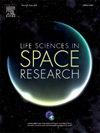用于太空植物栽培的水培法--白皮书
IF 2.9
3区 生物学
Q2 ASTRONOMY & ASTROPHYSICS
引用次数: 0
摘要
太空中的微重力条件阻碍了植物生长硬件根部模块中水分的适当分配,缺乏对流混合和浮力也减少了气体交换。为克服这一问题,应设计利用航天环境独特特性的栽培技术,而不是试图重新创造类似地球的条件。此类技术应既能适应太空飞行的微重力环境,也能适应月球和火星表面的低重力环境。目前的太空植物栽培依赖于传统的陆地栽培方法,使用的多孔基质养分贫乏且难以再生,而且没有考虑到太空中由地表或热梯度控制而非重力控制的水流占主导地位这一潜在的有益特性。我们提出了在无土栽培系统中通过平行但独立的方式控制水分分配和排除的系统,该系统可适应和扩展不同大小的作物以及浅根或深根植物。在无基质水培系统中,可通过雾化营养液结合特殊的根模块几何形状和温度梯度来实现水分的分配和去除。使用水凝胶作为基质以及为太空植物栽培提供所需的养分和水分的方法,可以帮助向低重力系统过渡,最终将现场碎石纳入其中,形成类似地球的土壤。本文章由计算机程序翻译,如有差异,请以英文原文为准。
Hydroponics for plant cultivation in space – a white paper
The microgravity conditions experienced in space prevent the proper distribution of water throughout root modules of plant growth hardware, and the lack of convective mixing and buoyancy reduces gas exchange. To overcome this problem, cultivation technologies should be designed that take advantage of the unique traits of the spaceflight environment instead of attempting to recreate Earth-like conditions. Such technologies should be adaptable to both the microgravity of spaceflight and the low gravity environments of the lunar and Martian surface. Current space plant cultivation relies on traditional terrestrial practices and uses porous substrates that are nutrient poor and difficult to regenerate, and does not consider the dominance of surface- or thermal gradient-controlled rather than gravity-controlled water flow in space as a potential beneficial property. We propose systems that control water dispensation and removal by parallel but independent means in a soil-free cultivation system that is adaptable and expandable to crops of varying sizes and shallow or deep rooting plants. Water dispensation and removal in a substrate-free hydroponic system can be achieved through the misting of nutrient solutions combined with special root module geometry and temperature gradients. The use of hydrogels as substrate, and a means of providing required nutrients and water for plant cultivation in space, can aid in the transition to low-gravity systems by eventual incorporation of on-site regolith to establish Earth-like soil.
求助全文
通过发布文献求助,成功后即可免费获取论文全文。
去求助
来源期刊

Life Sciences in Space Research
Agricultural and Biological Sciences-Agricultural and Biological Sciences (miscellaneous)
CiteScore
5.30
自引率
8.00%
发文量
69
期刊介绍:
Life Sciences in Space Research publishes high quality original research and review articles in areas previously covered by the Life Sciences section of COSPAR''s other society journal Advances in Space Research.
Life Sciences in Space Research features an editorial team of top scientists in the space radiation field and guarantees a fast turnaround time from submission to editorial decision.
 求助内容:
求助内容: 应助结果提醒方式:
应助结果提醒方式:


